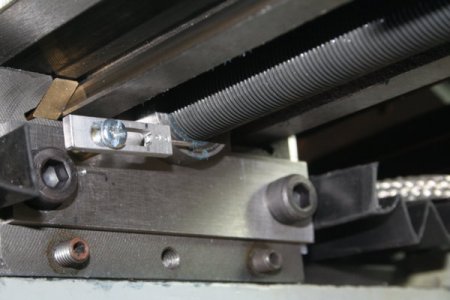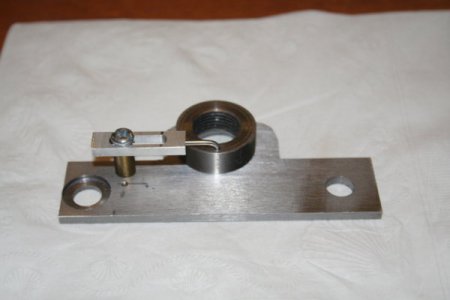- Joined
- Jul 28, 2017
- Messages
- 2,368
I've been working on a scheme for reducing backlash on my X2 mill for some time. After some false starts I believe I've done it. It is a variation on an approach used on the Sherline CNC mills, where each table axis has two, not one, lead screw nuts. In the Sherline design (sorry, I don't have any photos) for each axis there is a second nut on the exterior of the table, and it is in close contact to the table.. Its outer diameter is knurled with a fairly coarse knurl. The nut engages a thick washer whose OD also is knurled. The washer is fixed to the table with a bolt. To adjust the backlash, the bolt is slightly loosened and the washer is rotated to turn the feed screw nut, sort of like a pair of gears. In this manner the external feed screw nut is moved in or out to adjust the backlash. Once the backlash is set, the bolt is tightened.
I know, verbal descriptions can be hard to unravel. But I think the attached photo will clarify things. It shows a second feed screw nut (modified from a nut I bought from LMS). The photo shows the underside of the right-hand side of the table. The nut was drilled with a 1/16" hole to accommodate a short length of piano wire that was bent at the end. The other end of the piano wire is attached to an adjuster that has a slot cut in it. To set the backlash, the screw in the slot is loosened, then the adjuster is moved to tighten/loosen the nut. BTW I also made an end plate so the external nut had a "landing pad". The stock mill table is open on both ends so it was necessary to fabricate this piece. It was made from a piece of ground steel plate. I had to D/T two holes to mount the plate on the table. It was an interesting exercise to align the hole in the plate so there was no mechanical interference with the lead screw. I made a number of prints using Inkscape, which, on my system, seems to produce pretty accurate to-scale prints. I used the prints to do some trial fitting so I could avoid any major d'oh! moments.
Unlike the Sherline approach, due to the limited range of my adjuster scheme it is necessary to do a trial fit of the the nut so you know where to drill the hole for the piano wire. But I think there should be enough adjustment range to accommodate a lot of wear. Of course, you could always drill another hole in the nut when you need to...
.
I know, verbal descriptions can be hard to unravel. But I think the attached photo will clarify things. It shows a second feed screw nut (modified from a nut I bought from LMS). The photo shows the underside of the right-hand side of the table. The nut was drilled with a 1/16" hole to accommodate a short length of piano wire that was bent at the end. The other end of the piano wire is attached to an adjuster that has a slot cut in it. To set the backlash, the screw in the slot is loosened, then the adjuster is moved to tighten/loosen the nut. BTW I also made an end plate so the external nut had a "landing pad". The stock mill table is open on both ends so it was necessary to fabricate this piece. It was made from a piece of ground steel plate. I had to D/T two holes to mount the plate on the table. It was an interesting exercise to align the hole in the plate so there was no mechanical interference with the lead screw. I made a number of prints using Inkscape, which, on my system, seems to produce pretty accurate to-scale prints. I used the prints to do some trial fitting so I could avoid any major d'oh! moments.
Unlike the Sherline approach, due to the limited range of my adjuster scheme it is necessary to do a trial fit of the the nut so you know where to drill the hole for the piano wire. But I think there should be enough adjustment range to accommodate a lot of wear. Of course, you could always drill another hole in the nut when you need to...
.



